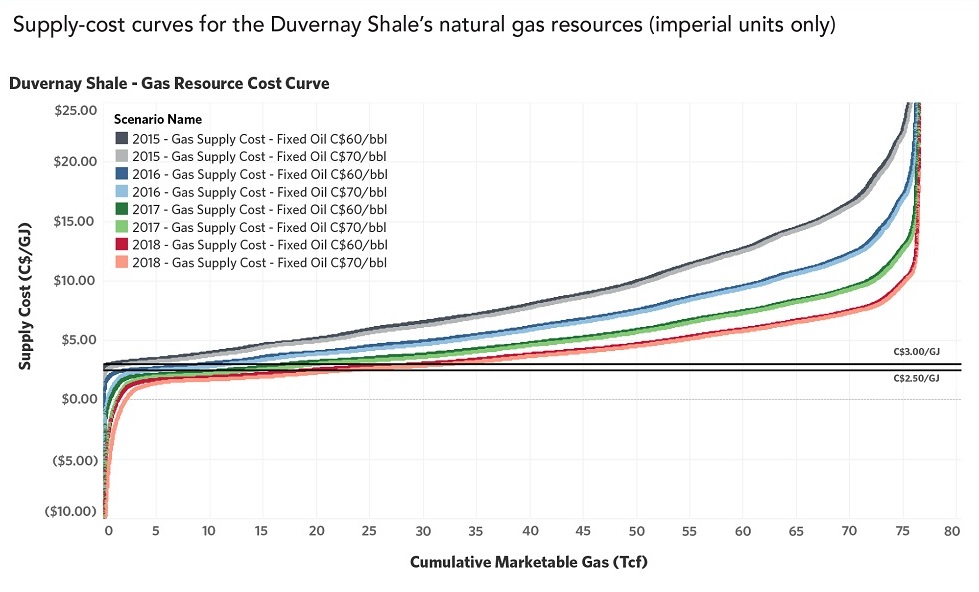
Crescent Point Energy now has over 355,000 acres in the Duvernay Shale Basin play
Crescent Point Energy Corp. announced that it bought 355,000 net acres in the Alberta East Shale Duvernay light oil resource play, at a low entry cost of $315 per acre for a total cost of $112 million, according to a press release. The buy makes Crescent Point a major player in the Duvernay Basin, which holds an estimated 443 trillion cubic feet of gas and 61.7 billion barrels of oil, and is located in central Alberta.
Throughout 2017, Crescent Point also focused on organically increasing its initial land position in the emerging East Shale Duvernay. Since its entry in 2015, the Company has completed detailed geological mapping in order to target high-quality land in the emerging light oil resource play. Crescent Point’s significant land position of over 355,000 net acres provides a high working-interest with strong land tenure.
“The Duvernay is very exciting for Crescent Point and is consistent with our strategy of developing large oil-in-place resource pools with low recovery to date. Our strategic land base combined with strong production results to date by industry, highlight the potential for scaleable growth that is not reflected in our 2018 production guidance or our current five-year plan,” said Scott Saxberg, president and CEO of Crescent Point.
To date, Crescent Point has participated in two gross (one net) non-operated horizontal wells with a lateral length of one-and-a-half-miles, the first of which has flowed at an impressive initial 30-day and 90-day rate of approximately 570 boe/d and 515 boe/d respectively, comprised of approximately 92 per cent oil and liquids.
The second well has been flowing for less than 30 days with initial rates similar to the first well. The company is currently planning to drill a total of four operated net wells in the first half of 2018. This drilling program is reflected in the company’s 2018 capital expenditures budget, which is expected to generate a total payout ratio of 99 per cent as previously disclosed on Jan. 9, 2018.
“The addition of the East Shale Duvernay play complements our asset base with additional high-impact light oil wells and operational flexibility,” said Saxberg.
Crescent Point Energy announced that first quarter 2018 production and cash flow from its U.S. assets have grown year-over year by approximately 60 per cent and 175 per cent.
“Our U.S. assets continue to grow and exceed expectations. Within our five-year plan, we expect production from these U.S. resource plays to more than double to approximately 80,000 boe/d. This growth is primarily driven by our Uinta Basin play and conservatively forecasts approximately 45 net horizontal wells drilled per year,” said Saxberg.
During first quarter 2018, Crescent Point successfully completed its first stacked horizontal development in the Uinta Basin, targeting the Castle Peak, Wasatch and Uteland Butte zones in the state of Utah.
After completing a Castle Peak two-mile horizontal well in second quarter 2017, which flowed at an initial 60-day rate of over 900 boe/d, Crescent Point recently curtailed production in order to drill and complete a dual pad targeting the Wasatch and Uteland Butte zones within the same drilling spacing unit.
Current production from the combined Wasatch and Uteland Butte zones is ahead of expectations at approximately 3,100 boe/d after 45 days and is comprised of approximately 93 per cent oil and liquids.
Furthermore, production from the Company’s Castle Peak well is now increasing since coming back online and has already produced over 205,000 boe in less than 230 days. Crescent Point is currently completing another stacked horizontal development targeting the same three zones.
“Our current horizontal type-wells in the Uinta Basin have attractive economics with the opportunity for improvement as we target cost reductions of over 10 percent through multi-well pad development,” said Saxberg. “During first quarter 2018, we completed a successful down-spacing program equivalent to an eight wells per drilling spacing unit. This highlights the potential for additional locations within our current inventory of approximately 850 net risked locations, which are primarily based on four wells per drilling spacing unit.”
As part of its risk management program to protect its cash flow and the strength of its balance sheet, Crescent Point says they remained active on its hedging program during first quarter 2018. As at April 2, 2018, the company had 53 per cent of its oil and liquids production, net of royalty interest, hedged for the remainder of 2018 at a weighted average market value price of approximately CDN$74.00/bbl.
For the first three quarters of 2019, 35 percent of its oil and liquids production is hedged at a weighted average market value price of approximately CDN$75.00/bbl. Crescent Point’s commodity hedges extend through 2019, including a significant amount of natural gas production hedged at a weighted average price of CDN$2.74/GJ.


Be the first to comment